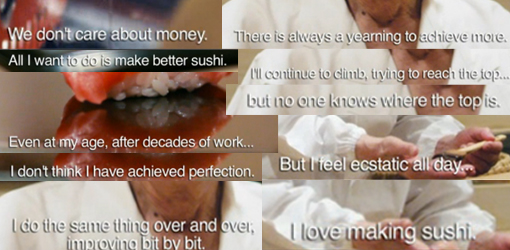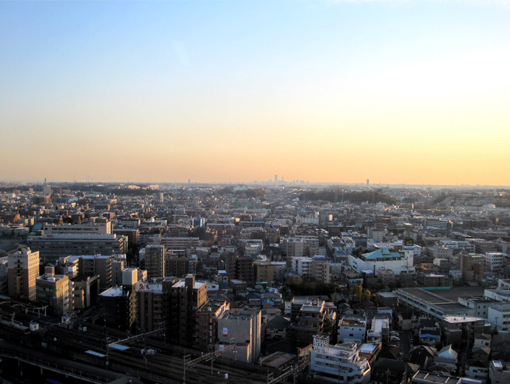When to Say When
Posted on December 14, 2012 | posted by:
“Hey isn’t this great, sushi in drug stores? Look at that selection. Gosh, Walgreens have really refined their taste, haven’t they?”
Every day in Ginza, Tokyo, Japan, a man gets up at 5 in the morning to refine his skills at his restaurant. To him, national holidays are a bore. Not because he doesn’t respect his country and love his family, but because it means he will be away from his work for too long. Despite making sushi for decades, he insists he has a long way to go. He knows every day holds a new opportunity to reach perfection, but is perfectly aware how impossible that achievement is.
Jiro Ono is the 85 year old hero of the documentary “Jiro Dreams of Sushi” directed by David Gelb. The chef of a 3 Michelin star restaurant (the highest number a restaurant can earn) is followed along his pursuit of art, as Jiro’s work is a true art form–a thoroughly conceptualized experience for his customers beginning well before they sit at his counter and after they leave. He speaks of making sure ingredients and their temperatures are in perfect harmony, creating a balance of flavors that elicit a unique, refreshing experience. His servings are based on what is available daily at the world-renowned Tsukiji fish market, ensuring the highest quality ingredients. The sushi version of those selections being served have been likened to listening to a concerto. The consideration of flavor, density, or delicacy of each piece compliment and build on each other and alternately slow the pace of the meal, with a bit of improvisation mixed in for fun. His restaurant is so renowned, lunch and dinner reservations must be booked a month in advance, drawing customers from all over the world just to eat at his restaurant, which sits in the basement of a Tokyo office building. Prices start at 30,000 Yen ($358.74). Despite these figures, Jiro’s aim is not money. He is a legend in his industry and a success in traditional terms because of his love and dedication to his craft.
Imitation tuna?
Equations in his line of work aren’t all as simple as dedication + creativity = sucessful results. One pivotal element that Jiro is confronted with on a daily basis is dwindling supplies. Many varieties of seafood he has offered in the past are becoming scarcer or worse, non-existent by the year. It’s a serious issue since sushi popularity has grown throughout the US and Europe since the mid 1980’s, compounded heavily by the proliferation of convenience-store sushi. Beyond being an insult to Jiro’s craft, it’s an irresponsible move on the part of the middle men who supply fish to these producers. This is a two-fold issue. On one hand the fish supply is low for those who depend on it for income, like Jiro. The second and more systemic issue is that this depletion deprives the ability to carry out their intended life-cycles, failing to contribute to the natural recycling system the oceans require, to stabilize that larger living system.
The practice of overfishing views fish of all types and ages suitable to be caught and sold, increasing their fishing as supply’s dwindle, following the adage that where there is enough money, resources will be obtained. Further, In Natural Capitalism, Paul Hawken, Amory Lovins and L. Hunter Lovins describe that once in the well-oiled machine of industry, if a product becomes scarce or too expensive to produce, a cheaper substitute will be made. This is very possible for synthetic or chemically produced items. But for products or species such as tuna, there will never be a replacement. When exactly will industries realize this impending fact?
Jiro and the authors of Natural Capitalism would argue that businesses need to be much more conscious of this situation, treating living systems not as an endless supply of resources to meet their economic needs, but to conduct business “as if living systems mattered” (pg.9, Natural Capitalism), and therefore had a conscious value placed on them before being over-fished out of existence, even back-tracking on the choice to offer sushi in convenience-store format, knowing that people as well as tuna are and will be affected by these thoughtless practices. “The climate debate is a public issue in which the assets at risk are not specific resources, like oil, fish or timber, but a life-supporting system” (pg.4). I would argue that no matter how small the specific resource, they greatly impact the larger life-supporting systems. We should be just as conscious of preserving them as their larger counterparts, as as this story outlines. No resource is too small to overlook.
Without sounding like the person who stands in front of the bulldozer with her sign, on her soapbox nonetheless, I am calling for those reading this blog to be conscious of what resources they interact with, where they purchase their products and to track the cycle of the consequences as far as possible, so as to be critical in your everyday and long-term actions. Oh, and Jiro would be much appreciative as well.
Arigatou gozaimasu. (Thank you very much).

